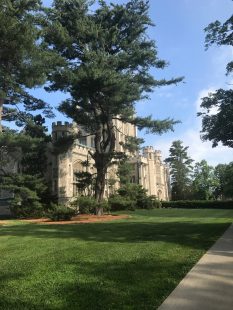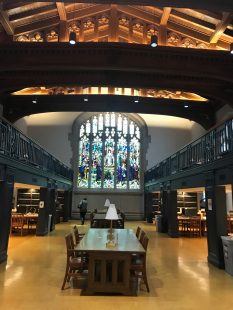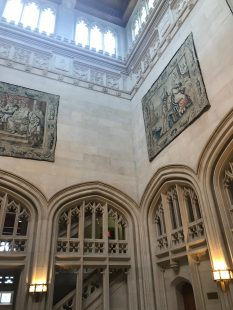Enabling faculty and students to attend high-quality workshops is one of the most valued opportunities supported by our Mellon DH grant. I recently returned from a 4-day trip to Philadelphia with Jon Eastwood (Laurent Boetsch Term Professor of Sociology) and three brilliant undergrads at W&L: Elena Diller, C’17 (Sociology major with minors in Poverty Studies and Women, Gender, and Sexuality Studies ), Dani Leon, C’18 (Politics/Sociology double major with a minor in Poverty Studies), and Kassie Scott (English/Sociology double major with a minor in Poverty Studies). Jon attended a workshop on Casual Inference with Directed Graphs taught by Felix Elwert; Elena, Dani, Kassie, and I attended a workshop on Social Network Analysis (SNA) taught by Steve Borgatti. The latter workshop was recommended to us by Professor Megan Hess (Accounting), who had taken a workshop with Borgatti before. Both short courses were hosted by Statistical Horizons.
This post will focus on the SNA workshop, though we all learned a fascinating amount about Directed Acyclic Graphs from Jon Eastwood over meals and during the long drive back from Philadelphia. Jon reports that he will be bringing what he learned into the classroom this Fall Term as part of the course he will be teaching on Bayesian data analysis.
The workshop was two intensive days, 9-5, that provided an in-depth introduction to SNA, particularly with the use of the UCINET software package developed by Borgatti. The W&L students were the only undergrads in attendance, which is an indicator of the quality of opportunities that this university provides students. The class size was 28, consisting mostly of faculty, professionals in fields such as public health, government, and social work, as well as a few grad students. Medical school faculty were prominently represented. The W&L undergrads, not shy about asking questions, easily kept up with their more educated classmates.
The instructor, Steve Borgatti, is one of the leading scholars in the field. Borgatti is currently president of the International Network for Social Network Analysis and has published a wealth of literature that has received over 40,000 citations. Borgatti is a humble man whose jovial and bearded presence in blue jeans never conveys any hint of his standing within academia. The pace of the workshop was intense, thought provoking, and exhausting but well worth the effort. Borgatti structured the 2-day workshop as a mixture of lecture (with over 200 slides) and hands-on practice with UCINET. Attendees came away with an understanding of how to import different data structures into UCINET and the many network measures provided by the software.
As a Windows program, UCINET works well on Macs via the Windows emulator Wine. Step-by-step instructions for installing on a Mac via WineBottler work really well. My one bit of advice on installation for Macs is to make a symbolic link to the UCINET data folder, which is installed by WineBottler at “/Users/[username]/Library/Application Support/com.yourcompany.yourapp[numeric string]/drive_c/users/[username]/My Documents/UCINET data”. A symbolic link from your Desktop or elsewhere will make it easy to access the data files generated by UCINET.
UCINET is a good alternative for people who prefer a menu-driven interface over the command-driven approach of R. I would definitely recommend UCINET over Gephi. For my own SNA research, I suspect I will stick with R’s igraph package but I’m going to explore the possibilities of UCINET. As far as software goes, UCINET is simple to learn. It mostly works the same way for any feature or network measure: find the desired option under the menus, load the data set, set any additional options, and run. UCINET also comes with a command-line interface. The extensive HELP file provides references to scholarly articles for a large number of functions provided by the software.
Due to the computational nature of SNA, people new to the topic often approach it as a methodology or a tool. Borgatti emphasizes a distinction between the “theory of networks” as a way of explaining why networks exist and “network theory” as a way of understanding the consequences of networks. Borgatti stated that most SNA studies are about the consequences of networks.
A significant part of the second day of the workshop focused on egonets, which is a network focused on one person (the “ego”) and the connections that person has with others (the “alters”). Building on that discussion was an examination of social resource theory, associated with the scholar Nan Lin. Another conception of social capital is articulated by scholar Ron Burt via network analysis in the form of structural holes.
A variety of measures exist for SNA but I’m finding in my own research into literary networks that absorbing the network theory before embarking on the actual data analysis is having a positive impact on my understanding of the patterns and connections within literary publishing. Previously I have thrown my data set into network visualization tools as a means of exploring the data but I now feel better equipped to think about exactly which measures I should examine for better understanding the interchange among editors and authors in producing the outcome that is a literary magazine.
Borgatti covered a great number of topics in the two days, including a very mathematical discussion of the types of regression that can be done on network matrices. He also gave an overview of exponential random graph models (ERGMs) as a computational model for predicting the absence or presence of connections within a network.
SNA is not just about contemporary issues. Borgatti used the data set from a well-known study on the relationship of marriage and business ties among 15th century Florentine families that led to the rise of the Medici. Another historical topic covered was a study of 12th century Russia and the emergence of Moscow as a dominant location due to trade routes. In the latter study, we see that SNA can be applied to areas other than just interpersonal relationships. As Borgatti says, “Networks are everywhere” and network studies are found in the natural sciences, the social sciences, and the humanities.
I already mentioned the professional organization INSNA, which tends to focus on the social sciences. Another organization, the Network Science Society, focuses more on physics, computer science, biology, etc. While there is overlap among the two professional organizations, Borgatti describes the two as still “having a different feel”.
I’ll wrap up this report with a suggested reading. Just about anything by Borgatti is worthwhile, and a good starting point is his 2009 article in Science on Network Analysis in the Social Sciences. I highly recommend reading about the theories behind social network analysis and how those apply to your own research questions. Grasping those concepts before jumping into the tools of SNA will be very beneficial. Borgatti and his colleagues at the University of Kentucky’s LINKS Center for Social Network Analysis also have published an insightful article on Social Network Research: Confusions, Criticisms, and Controversies [PDF preprint].


